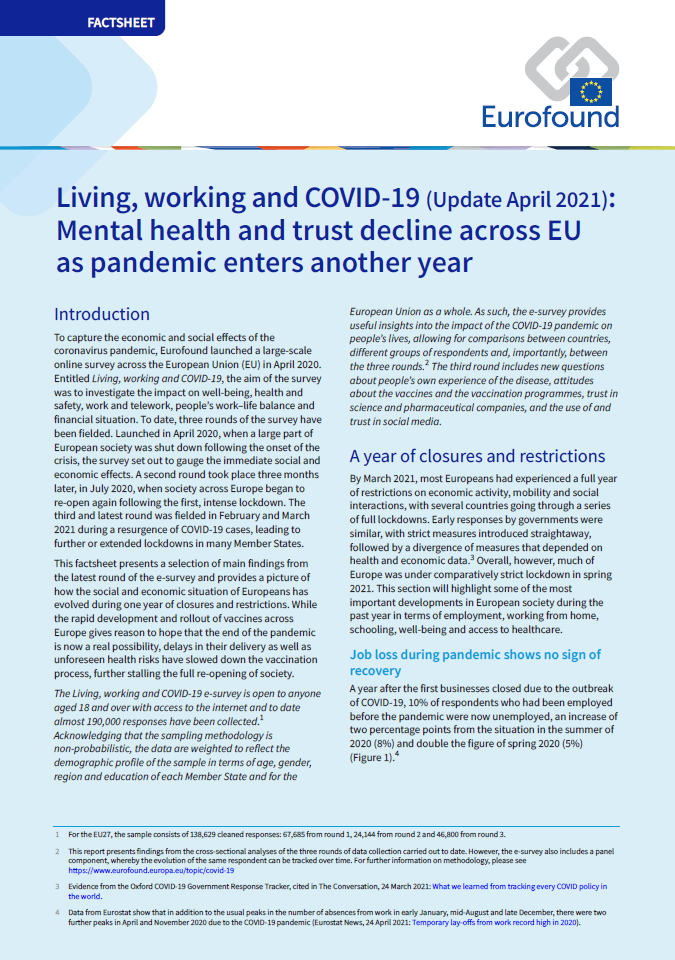
Eiropas Dzīves un darba apstākļu uzlabošanas fonda (Eurofound) e-pētījuma trešā kārta, kas veikta februārī un martā, atklāj sociālo un ekonomisko situāciju, kādā atrodas cilvēki visā Eiropā, gandrīz jau gadu sadzīvojot ar COVID-19 ierobežojumiem. Šajā ziņojumā tiek analizēti galvenie pētījuma rezultāti un tiek sekots situācijas attīstībai un tendencēm visās 27 ES dalībvalstīs, kopš pētījuma uzsākšanas 2020. gada aprīlī. Tajā ir precīzi norādīts uz problēmām, kas ir izkristalizējušās pandēmijas gaitā, proti, pieaugošā nedrošība par darbu, darba zaudēšanas apdraudējuma dēļ, garīgās labsajūtas stāvokļa pasliktināšanās, nesen iegūtās dzimumu līdztiesības pakāpeniska iznīcināšana, uzticības mazināšanās attiecībā uz iestādēm, darba un privātās dzīves līdzsvarotības pasliktināšanās un pieaugošā vilcināšanās vakcinēties. Pētījuma rezultāti iezīmē nepieciešamību pēc holistiskas pieejas, lai sniegtu atbalstu visām tām grupām, kuras ir smagi skārusi krīze, lai novērstu, ka tās atpaliek vēl vairāk.
Key findings
Kopš pandēmijas sākuma vairāk kā pirms gada garīgā labsajūta visās vecuma grupās ir sasniegusi zemāko līmeni. Jo īpaši tas ir saredzams jauniešu un cilvēku, kas ir zaudējuši darbu, vidū.
Pastāvošā nevienlīdzība paplašinās dēl pandēmijas nesamērīgās ietekmes uz mazāk aizsargāto iedzīvotāju grupu. No pētījuma rezultātiem izriet, ka “grūtības savilkt galus kopā”, būtiski ietekmē tos, kuri jau atrodas nedrošā situācijā.
Pilsoņu apmierinātība ar krīzes atbalsta pasākumiem ir krasi samazinājusies, šobrīd tikai 12% uzskata, ka atbalsta pasākumi ir godīgi, salīdzinot ar 22% 2020. gada vasarā. No 16% 2020. gada vasarā līdz 10% 2021. gada pavasarī ir samazinājusies arī to daļa, kas uzskatīja, ka atbalsta saņemšana bija vienkārša un efektīva. Gandrīz vienam no desmit respondentiem lūgums par finansiālo atbalstu tika noraidīts.
Uzticība iestādēm ir strauji kritusies, jo īpaši uzticība valstu valdībām, kas salīdzinot ar 4,6 2020. gada vasarā ir samazinājusies līdz 3,9 2021. gada pavasarī. Uzticība valstu valdībām visās dalībvalstīs noslīdēja zemāk par līmeni, kas tika reģistrēts pandēmijas sākumā. Arī uzticība ES ir samazinājusies, tomēr tā ir lielāka nekā uzticība valstu valdībām.
Vairāk nekā ceturtā daļa Eiropā dzīvojošo cilvēku vilcinās ar COVID-19 vakcīnu, noskaidrots, ka vīrieši vilcinās vairāk (29%) nekā sievietes (25%). Vilcināšanās vakcinēties ir arī cieši saistīta ar zemo uzticības līmeni un sociālo mediju izmantošanu, valstīs, kurās ir zems uzticības līmenis valdībai, ir novērojama lielāka vilcināšanās vakcinēties.
Explore the dataset for each round of the survey.
The data cover a range of topics under seven main headings: quality of life, democracy and trust, work and teleworking, the financial situation and security of respondents, the quality of public services, the employment support measures put in place, as well as the willingness of Europeans to be vaccinated during COVID-19.
- Data: Quality of life during COVID-19
- Data: Democracy and trust during COVID-19 (new in round 3)
- Data: Working during COVID-19
- Data: Financial situation and security during COVID-19
- Data: Quality of public services during COVID-19
- Data: Support measures during COVID-19 (new in round 3)
- Data: Vaccinations during COVID-19 (new in round 3)
The report contains the following lists of tables and figures. The corresponding data for the tables and figures is available as an Excel download (328KB .xlsx).
List of tables
- Table 1: Location of work and average hours worked during the pandemic, EU27 (%)
- Table 2: Proportion of parents declaring they are too tired after work to do household jobs, EU27 (%)
- Table 3: Proportion of respondents reporting having negative feelings by age and gender, EU27 (%)
- Table 4: Request for support by employment status, EU27 (%)
- Table 5: Proportion of financially fragile respondents by employment status, EU27 (%)
- Table 6: Proportion of respondents reporting difficulties making ends meet by employment status, EU27 (%)
- Table 7: Proportion of respondents reporting arrears by group, EU27 (%)
- Table 8: Trust in the EU by sociodemographic group (mean scores), EU27 (%)
- Table 9: Trust in the national government and the EU by financial support (mean scores), EU27 (%)
List of figures
- Figure 1: Respondents who lost their job (of those who were employed before the pandemic) by country, EU27 (%)
- Figure 2: Preference to work from home post-pandemic, EU27 (%)
- Figure 3: Proportion of parents declaring they would like more online schooling for their children, even when the pandemic is over, EU27 (%)
- Figure 4: Risk of depression by age group and survey round, EU27 (%)
- Figure 5: Unmet need for healthcare during the pandemic by country, EU27 (%)
- Figure 6: Unmet need for healthcare by type of healthcare, spring 2021, EU27 (%)
- Figure 7: Requests for different types of support measures, summer 2020 and spring 2021, EU27 (%)
- Figure 8: Views about pandemic support measures, summer 2020 and spring 2021, EU27 (%)
- Figure 9: Views about pandemic support measures by country, spring 2021, EU27 (%)
- Figure 10: Proportion of respondents reporting difficulties making ends meet by country, EU27 (%)
- Figure 11: Pessimism about financial situation by economic situation, EU27 (%)
- Figure 12: Proportion of respondents stating that their financial situation will get worse, EU27 (%)
- Figure 13: Trust in institutions (mean scores), EU27 (%)
- Figure 14: Trust in the EU by country (mean scores), EU27 (%)
- Figure 15: Trust in national governments by country and survey round, EU27 (%)
- Figure 16: Stated intention to take vaccine by country, EU27 (%)
- Figure 17: Sociodemographic characteristics of people with vaccine hesitancy in Europe, EU27 (%)
- Figure 18: Reasons for vaccine hesitancy, EU27 (%)
- Figure 19: Trust in institutions among people who are vaccine hesitant and non-hesitant, EU27 (%)
- Figure 20: Vaccination hesitancy before and after 11 March 2021, EU27 (%)
- Infographic: Living, working and COVID-19
